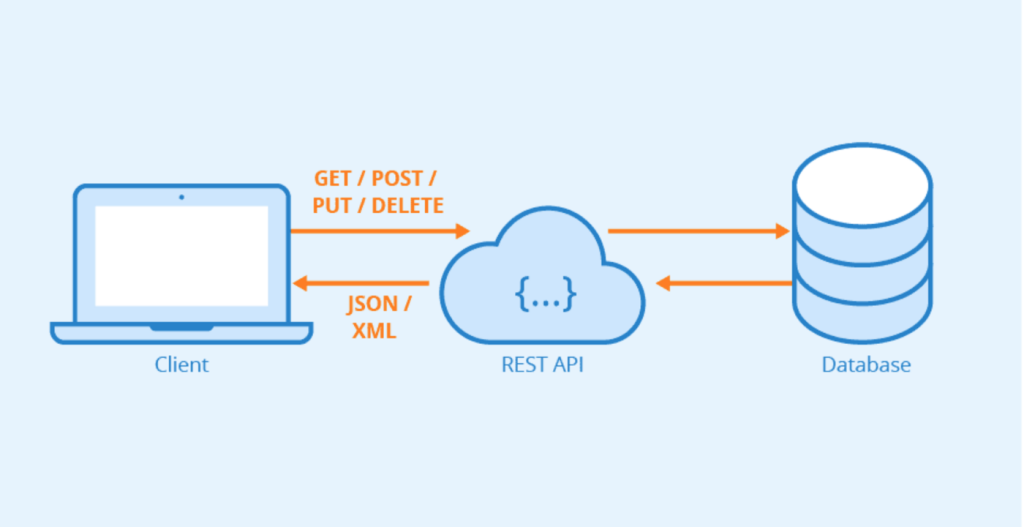REST (REpresentational State Transfer) is an architectural style for developing web services. REST is popular due to its simplicity and the fact that it builds upon existing systems and features of the internet’s Hypertext Transfer Protocol (HTTP) in order to achieve its objectives, as opposed to creating new standards, frameworks and technologies.
Advantages of REST
A primary benefit of using REST, both from a client and server’s perspective, is REST-based interactions happen using constructs that are familiar to anyone who is accustomed to using the internet’s HTTP.
An example of this arrangement is REST-based interactions all communicate their status using standard HTTP status codes. So, a 404 means a requested resource wasn’t found; a 401 code means the request wasn’t authorized; a 200 code means everything is OK; and a 500 means there was an unrecoverable application error on the server.
Similarly, details such as encryption and data transport integrity are solved not by adding new frameworks or technologies, but instead by relying on well-known Secure Sockets Layer (SSL) encryption and Transport Layer Security (TLS). So, the entire REST architecture is built upon concepts with which most developers are already familiar.
REST is also a language-independent architectural style. REST-based applications can be written using any language, be it Java, Kotlin, .NET, AngularJS or JavaScript. As long as a programming language can make web-based requests using HTTP, it is possible for that language to be used to invoke a RESTful API or web service. Similarly, RESTful web services can be written using any language, so developers tasked with implementing such services can choose technologies that work best for their situation.
The other benefit of using REST is its pervasiveness. On the server side, there are a variety of REST-based frameworksfor helping developers create RESTful web services, including RESTlet and Apache CXF. From the client side, all of the new JavaScript frameworks, such as JQuery, Node.js, Angular and EmberJS, all have standard libraries built into their APIs that make invoking RESTful web services and consuming the XML- or JSON-based data they return a relatively straightforward endeavor.
Disadvantages of REST
The benefit of REST using HTTP constructs also creates restrictions, however. Many of the limitations of HTTP likewise turn into shortcomings of the REST architectural style. For example, HTTP does not store state-based information between request-response cycles, which means REST-based applications must be stateless and any state management tasks must be performed by the client.
Similarly, since HTTP doesn’t have any mechanism to send push notifications from the server to the client, it is difficult to implement any type of services where the server updates the client without the use of client-side polling of the server or some other type of web hook.
From an implementation standpoint, a common problem with REST is the fact that developers disagree with exactly what it means to be REST-based. Some software developers incorrectly consider anything that isn’t SOAP-based to be RESTful. Driving this common misconception about REST is the fact that it is an architectural style, so there is no reference implementation or definitive standard that will confirm whether a given design is RESTful. As a result, there is discourse as to whether a given API conforms to REST-based principles.
Alternatives to REST
Alternate technologies for creating SOA-based systems or creating APIs for invoking remote microservices include XML over HTTP (XML-RPC), CORBA, RMI over IIOP and the Simple Object Access Protocol (SOAP). Each technology has its own set of benefits and drawbacks, but the compelling feature of REST that sets it apart is the fact that, rather than asking a developer to work with a set of custom protocols or to create a special data format for exchanging messages between a client and a server, REST insists the best way to implement a network-based web service is to simply use the basic construct of the network protocol itself, which in the case of the internet is HTTP. This is an important point, as REST is not intended to apply just to the internet; rather, its principles are intended to apply to all protocols, including WEBDAV and FTP.
REST vs. SOAP
The two competing styles for implementing web services are REST and SOAP. The fundamental difference between the two is the philosophical approach the two have to remotely invocations.
REST takes a resource-based approach to web-based interactions. With REST, you locate a resource on the server, and you choose to either update that resource, delete it or get some information about it.
With SOAP, the client doesn’t choose to interact directly with a resource, but instead calls a service, and that service mitigates access to the various objects and resources behind the scenes.
SOAP has also built a large number of frameworks and APIs on top of HTTP, including the Web Services Description Language (WSDL), which defines the structure of data that gets passed back and forth between the client and the server.
Some problem domains are served well by the ability to stringently define the message format or can benefit from using various SOAP-related APIs, such as WS-Eventing, WS-Notification and WS-Security. There are times when HTTP cannot provide the level of functionality an application might require, and in these cases, using SOAP is preferable.


